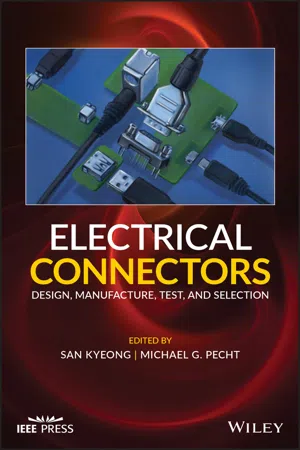
Electrical Connectors
Design, Manufacture, Test, and Selection
San Kyeong, Michael G. Pecht, San Kyeong , Michael G. Pecht
- English
- ePUB (handyfreundlich)
- Über iOS und Android verfügbar
Electrical Connectors
Design, Manufacture, Test, and Selection
San Kyeong, Michael G. Pecht, San Kyeong , Michael G. Pecht
Über dieses Buch
Discover the foundations and nuances of electrical connectors in this comprehensive and insightful resource
Electrical Connectors: Design, Manufacture, Test, and Selection delivers a comprehensive discussion of electrical connectors, from the components and materials that comprise them to their classifications and underwater, power, and high-speed signal applications. Accomplished engineer and author Michael G. Pecht offers readers a thorough explanation of the key performance and reliability concerns and trade-offs involved in electrical connector selection.
Readers, both at introductory and advanced levels, will discover the latest industry standards for performance, reliability, and safety assurance. The book discusses everything a student or practicing engineer might require to design, manufacture, or select a connector for any targeted application. The science of contact physics, contact finishes, housing materials, andthe full connector assembly process are all discussed at length, as are test methods, performance, and guidelines for various applications.
Electrical Connectors covers a wide variety of other relevant and current topics, like:
- A comprehensive description of all electrical connectors, including their materials, components, applications, and classifications
- A discussion of the design and manufacture of all parts of a connector
- Application-specific criteria for contact resistance, signal quality, and temperature rise
- An examination of key suppliers, materials used, and the different types of data provided
- A presentation of guidelines for end-users involved in connector selection and design
Perfect for connector manufacturers who select, design, and assemble connectors for their products or the end users who concern themselves with operational reliability of the systemin which they're installed, Electrical Connectors also belongs on the bookshelves of students learning the basics of electrical contacts and those who seek a general reference with best-practice advice on how to choose and test connectors for targeted applications.
Häufig gestellte Fragen
Information
1
What Is an Electrical Connector?
1.1 Challenges of Separable Connectors
1.2 Components of a Connector
1.2.1 Contact Springs


Inhaltsverzeichnis
- Cover
- Table of Contents
- Title Page
- Copyright
- About the Editors
- List of Contributors
- Preface
- 1 What Is an Electrical Connector?
- 2 Connector Housing
- 3 Contact Spring
- 4 Contact Plating
- 5 Insertion and Extraction Forces
- 6 Contact Interface
- 7 The Back‐End Connection
- 8 Loads and Failure Mechanisms
- 9 Fretting in Connectors
- 10 Testing
- 11 Supplier Selection
- 12 Selecting the Right Connector
- 13 Signal Connector Selection
- 14 Advanced Technology Attachment Connectors
- 15 Power Connectors
- 16 Electrical Connectors for Underwater Applications
- 17 Examples of Connectors
- Appendix A: Standards
- Index
- End User License Agreement